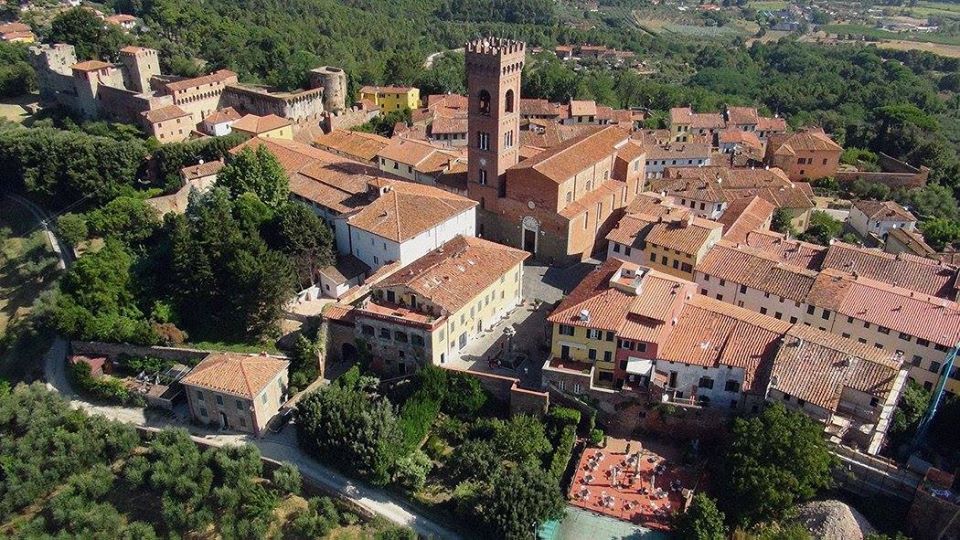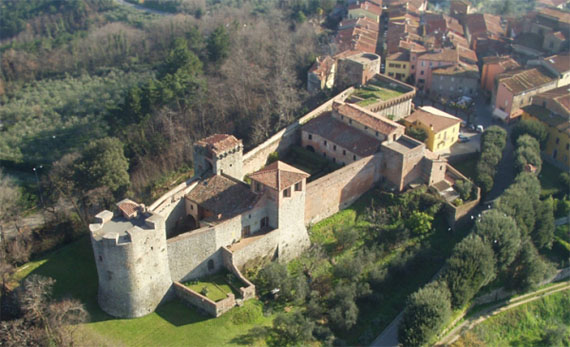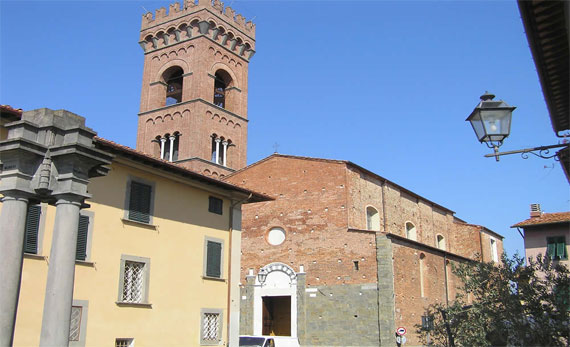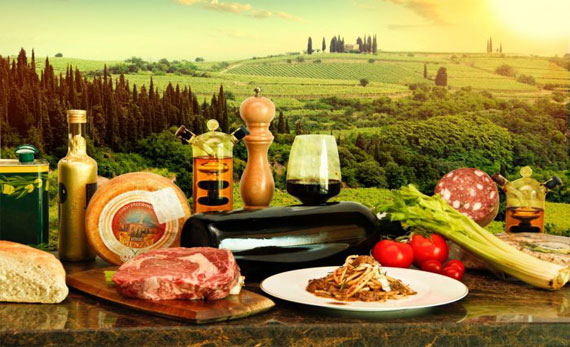
Montecarlo
The medieval village of Montecarlo di Lucca is a small jewel hidden in the heart of the Tuscan countryside.
The historic center, well preserved and still surrounded by the splendid city walls, stands on an isolated hill giving a breathtaking landscape. All around extends a territory famous for the beauty of its landscapes, with the cultivation of vines and olive trees for the production of Montecarlo DOC, oil and flowers.
Walking through its ancient alleys you can breathe the atmosphere at first sight silent and peaceful. In reality it is a country rich in history and ready to welcome tourists with numerous activities.

Montecarlo's Fortress
Montecarlo, because of its strategic position between two valleys, Lucca and Valdinievole, in the Middle Ages was crucial for the struggles between the powerful of Tuscany. The town of Montecarlo was built in 1333 to collect the inhabitants of the Vivinaia community, destroyed by the Florentines in 1331 at the Cerruglio fortress. The village was called Montecarlo in honor of Prince Charles, son of King John of Bohemia, liberator of Lucca from Pisa occupation.
Rassicurati's Teatre
The Theatre of Rassicurati undoubtedly worth a visit, if not participation in one of the many performances that are brought on stage, It’s a small pearl entirely made of wood, completely finished in detail.
Among the ancient theaters, Rassicurati is the second smallest in Europe, with its 150 seats and an important historical value. The theater dates back to 1639, when the Accademia degli Assicurati was formed, a group of young actors, who decided to form a stable company for the country that hosted only foreign companies.

The church Collegiata of Sanit’Andrea
On the main road of Montecarlo, the Via Roma, we find the Collegiate Church of S. Andrea, renovated towards the end of the 1700s, but which still retains the facade and portal of the fourteenth-century construction. Inside there is the chapel of the Madonna del Soccorso, protector of Montecarlesi.

The witches oak
Another little secret 5 minutes by car from this enchanting place is represented by the "Withces oak" or "Quercione", as the inhabitants of Montecarlo call it. A wonderful oak, which boasts an approximate age of 600 years, 15 meters high, with a circumference of 4 meters and a crown of over 40 meters in diameter.
Enogastronomic experience
Last, but not least, the motivation that leads to visiting Montecarlo is food and wine. For wine and oil enthusiasts, this is a must. Montecarlo is the ideal place to taste the flavors of the typical Made in Tuscany fine products. The history of the village is inextricably intertwined with that of its wine. The entire rural area has always specialized in the cultivation of vines. Along the wine and oil road that crosses the Valdinievole, from Lucca to Versilia, it is possible to taste the DOC Montecarlo white or red wine.

Montecarlo
The medieval village of Montecarlo di Lucca is a small jewel hidden in the heart of the Tuscan countryside.
The historic center, well preserved and still surrounded by the splendid city walls, stands on an isolated hill giving a breathtaking landscape. All around extends a territory famous for the beauty of its landscapes, with the cultivation of vines and olive trees for the production of Montecarlo DOC, oil and flowers.
Walking through its ancient alleys you can breathe the atmosphere at first sight silent and peaceful. In reality it is a country rich in history and ready to welcome tourists with numerous activities.

Montecarlo's Fortress
Montecarlo, because of its strategic position between two valleys, Lucca and Valdinievole, in the Middle Ages was crucial for the struggles between the powerful of Tuscany. The town of Montecarlo was built in 1333 to collect the inhabitants of the Vivinaia community, destroyed by the Florentines in 1331 at the Cerruglio fortress. The village was called Montecarlo in honor of Prince Charles, son of King John of Bohemia, liberator of Lucca from Pisa occupation.
Rassicurati's Teatre
The Theatre of Rassicurati undoubtedly worth a visit, if not participation in one of the many performances that are brought on stage, It’s a small pearl entirely made of wood, completely finished in detail.
Among the ancient theaters, Rassicurati is the second smallest in Europe, with its 150 seats and an important historical value. The theater dates back to 1639, when the Accademia degli Assicurati was formed, a group of young actors, who decided to form a stable company for the country that hosted only foreign companies.

The church Collegiata of Sanit’Andrea
On the main road of Montecarlo, the Via Roma, we find the Collegiate Church of S. Andrea, renovated towards the end of the 1700s, but which still retains the facade and portal of the fourteenth-century construction. Inside there is the chapel of the Madonna del Soccorso, protector of Montecarlesi.

The witches oak
Another little secret 5 minutes by car from this enchanting place is represented by the "Withces oak" or "Quercione", as the inhabitants of Montecarlo call it. A wonderful oak, which boasts an approximate age of 600 years, 15 meters high, with a circumference of 4 meters and a crown of over 40 meters in diameter.
Enogastronomic experience
Last, but not least, the motivation that leads to visiting Montecarlo is food and wine. For wine and oil enthusiasts, this is a must. Montecarlo is the ideal place to taste the flavors of the typical Made in Tuscany fine products. The history of the village is inextricably intertwined with that of its wine. The entire rural area has always specialized in the cultivation of vines. Along the wine and oil road that crosses the Valdinievole, from Lucca to Versilia, it is possible to taste the DOC Montecarlo white or red wine.

Montecarlo
The medieval village of Montecarlo di Lucca is a small jewel hidden in the heart of the Tuscan countryside.
The historic center, well preserved and still surrounded by the splendid city walls, stands on an isolated hill giving a breathtaking landscape. All around extends a territory famous for the beauty of its landscapes, with the cultivation of vines and olive trees for the production of Montecarlo DOC, oil and flowers.
Walking through its ancient alleys you can breathe the atmosphere at first sight silent and peaceful. In reality it is a country rich in history and ready to welcome tourists with numerous activities.

Montecarlo's Fortress
Montecarlo, because of its strategic position between two valleys, Lucca and Valdinievole, in the Middle Ages was crucial for the struggles between the powerful of Tuscany. The town of Montecarlo was built in 1333 to collect the inhabitants of the Vivinaia community, destroyed by the Florentines in 1331 at the Cerruglio fortress. The village was called Montecarlo in honor of Prince Charles, son of King John of Bohemia, liberator of Lucca from Pisa occupation.
Rassicurati's Teatre
The Theatre of Rassicurati undoubtedly worth a visit, if not participation in one of the many performances that are brought on stage, It’s a small pearl entirely made of wood, completely finished in detail.
Among the ancient theaters, Rassicurati is the second smallest in Europe, with its 150 seats and an important historical value. The theater dates back to 1639, when the Accademia degli Assicurati was formed, a group of young actors, who decided to form a stable company for the country that hosted only foreign companies.

The church Collegiata of Sanit’Andrea
On the main road of Montecarlo, the Via Roma, we find the Collegiate Church of S. Andrea, renovated towards the end of the 1700s, but which still retains the facade and portal of the fourteenth-century construction. Inside there is the chapel of the Madonna del Soccorso, protector of Montecarlesi.

The witches oak
Another little secret 5 minutes by car from this enchanting place is represented by the "Withces oak" or "Quercione", as the inhabitants of Montecarlo call it. A wonderful oak, which boasts an approximate age of 600 years, 15 meters high, with a circumference of 4 meters and a crown of over 40 meters in diameter.
Enograstronomic Experience
Last, but not least, the motivation that leads to visiting Montecarlo is food and wine. For wine and oil enthusiasts, this is a must. Montecarlo is the ideal place to taste the flavors of the typical Made in Tuscany fine products. The history of the village is inextricably intertwined with that of its wine. The entire rural area has always specialized in the cultivation of vines. Along the wine and oil road that crosses the Valdinievole, from Lucca to Versilia, it is possible to taste the DOC Montecarlo white or red wine.




